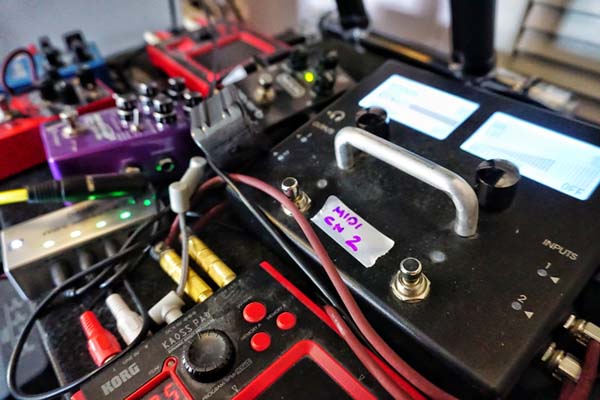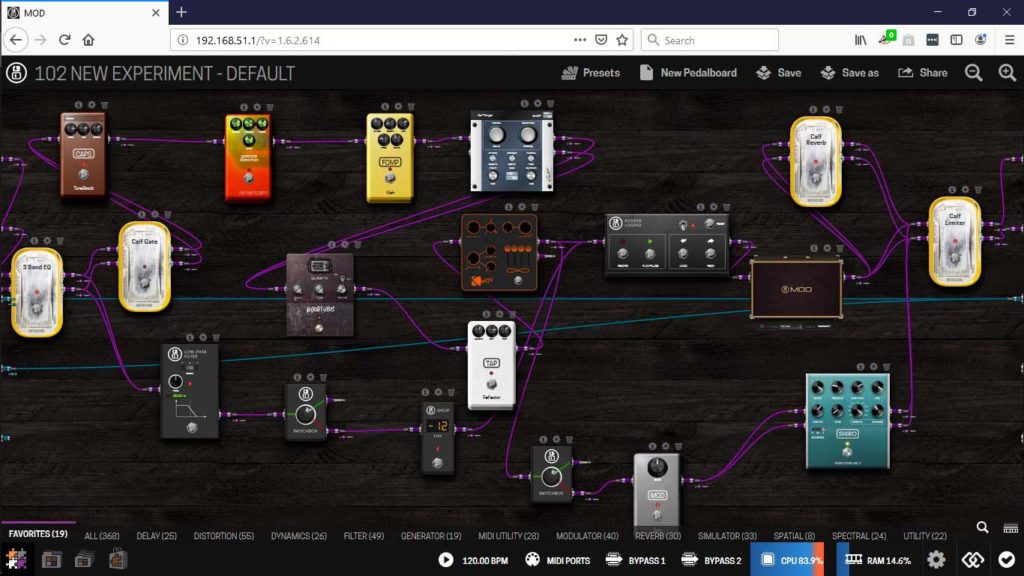Having posted a new gear page the other day, I’ve been thinking how best to represent the complexity of how I use my whole set up. The plan is to blog about different aspects of it that deserve expansion, and then link to the these blog posts from the gear page. Hopefully it’ll shed a little more light on how some of this stuff works.
I will say that the fullest exploration of my pedal set-up so far is in two of the courses that I’ve filmed for scottsbasslessons.com – the looping one and the pedals and effects one. If you’re a member there, make sure you watch those lessons!
So our first post here is going to be about the MOD Devices Duo. For almost 20 years, my main effects processor was a Lexicon MPX-G2 – despite all the leaps forward in processing power and modelling technology, until I came across the Duo, I hadn’t found anything that felt like a significant step forward from that. What I love the most about the Duo is that the signal path is configurable in any imaginable routing combination. Here’s my main pedalboard:Â
If you click on it and have a look at how the signal flows through it, you’ll see a couple of interesting things – firstly the octaver runs parallel to all the overdrive, envelope filtering and modulation – so the sub octave remains clean no matter what is happening to the normal octave signal. There are definitely times when running an octaver into an overdrive can sound really cool, and I have the MXR Sub Octave Bass Fuzz on my pedal board before the Duo to deal with that. Here, I have an amazing clean sub bass signal available no matter what level of craziness is happening on top.
Then, you can see that the Shiro shimmer reverb – bottom right, pale blue – is in another side chain, with a switch before it to turn the signal going to it on and off, but not to cut off the reverb. It’s set to 60 seconds of decay, so if I send a signal into it, then cut it off, the reverb continues to sound for a whole minute before disappearing. This means I can use it to set up big synth-like chords and then play melodies or chords against it, without having to loop the whole ambient part first. I can have it evolve over time, making for much more complex interaction – I can send individual notes from whatever else I’m playing into the 60 second shimmer verb, becoming part of the harmony of that ambient pad.
The only pedal after the Duo in my pedal set up is the MXR Reverb, which I actually use in a similar way to the Shimmer verb – I have it set up in ‘buffered bypass’ mode, so that when I turn it off, any reverb tail that’s current sounding will continue to play and gradually fade, and I can continue to play without affecting that. It’s like it has a parallel path within it, and I can switch the signal to go through it or past it. A very very useful setting that exists on a number of time-based effects pedals though not all.
I have other patches that use this process in far more complex ways, which maybe I’ll write about and screengrab in the future, but for now, hopefully that gives some clue as to what’s going on. The Duo offers so many possibilities, with its library of several hundred pedals that can be inserted into any board that all come free with it (there are a handful of paid pedals, many of which I’ve bought and are incredible, but the vast majority are free). combining them, and even being able to have synths in the same patch as direct signal processing, makes the Duo easily my favourite multi-FX unit I’ve ever used.
I control it with the Keith McMillen Softstep 2 foot controller, and have 8 buttons that I can assign to turn things on and off, as well as one continuous controller pedal for wah, volume and reverb level… (the Softstep is also controlling the Looperlative, and could also control any other MIDI think I might add to the set-up!) I’ve also got my old phone set up as a MIDI-over-USB controller, but haven’t got that hooked up at the moment! There are only so many things I can think about at one time!
I hope that’s a useful explanation. If you want to hear this board in action, check out my video for the track Divinity DT & Daniel  which uses this exact board, or the one for The Field Of Strategic Possibilities which uses it for the first 7 mins, before I switch to a different pedal board (you can see where that happens in the video 🙂 ) – both of these tunes, and 47 (FORTY SEVEN!) other albums are available from my Bandcamp subscription the moment you sign up… There’s an awful lot of applied signal processing to explore there 🙂


